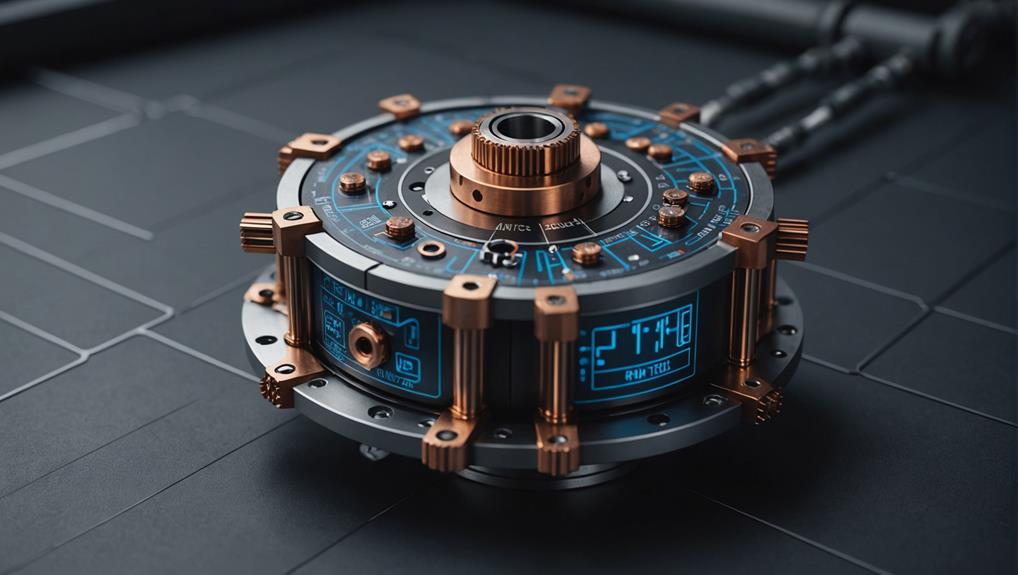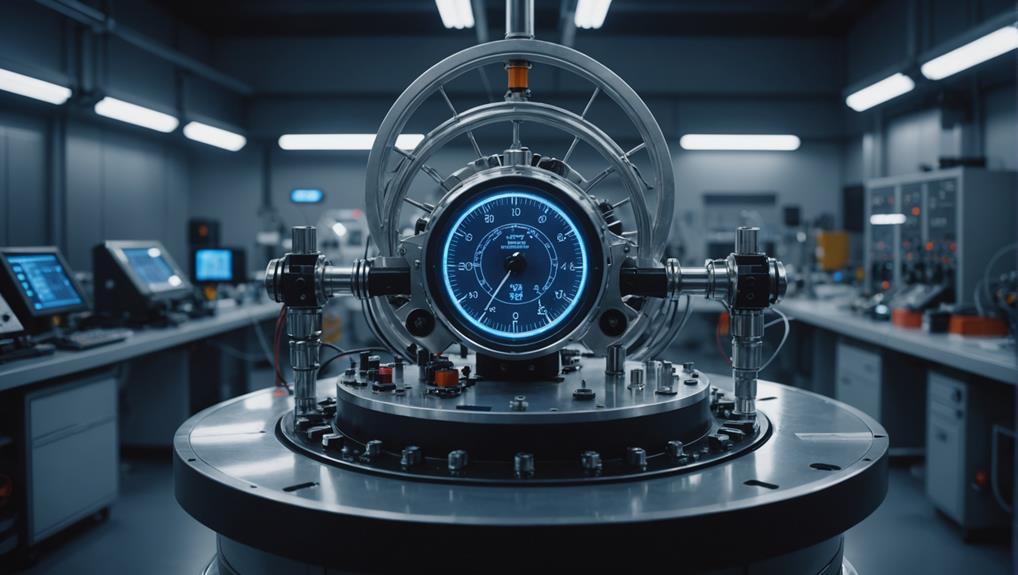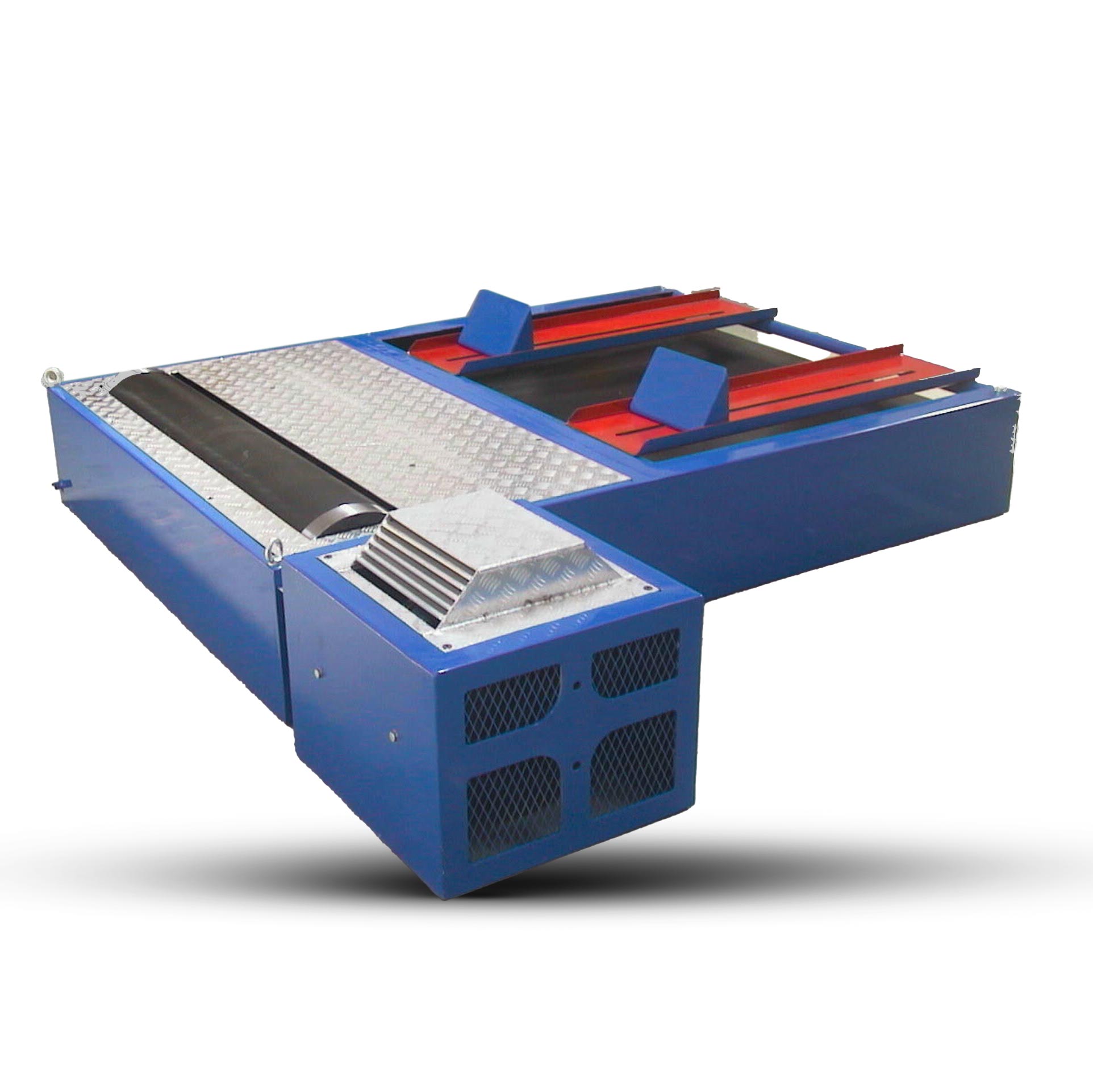
How Dynamometers Enhance Engine Diagnostics and Testing
Necessitating precise measurements, dynamometers unlock the secrets of engine performance, but what else can they reveal about engine diagnostics and testing?
When comparing inertia and brake dynamometers for accuracy, it is essential to understand their operating principles and advantages.
Inertia dynamometers offer improved accuracy, cost-effectiveness, and the ability to perform wide-open throttle testing, making them suitable for industries such as robotics and medical.
In contrast, brake dynamometers are associated with high maintenance costs due to their complex design, requiring regular calibration and fluid replacements.
Inertia dynamometers provide accurate and consistent results, simulating real-world road conditions through calculating equivalent mass.
As the choice between these dynamometers can significantly impact testing results, a thorough comprehension of their differences is crucial to guarantee accurate measurements and informed decisions.
A dynamometer's operating principle is fundamentally linked to its type, and understanding the distinctions between inertia and brake dynamometers is essential for selecting the right tool for a specific application.
Inertia dynamometers, also known as inertia dynos, utilise a fixed inertial mass load to calculate the power required to start or accelerate the set amount of mass load, recording acceleration rate along with rpm using a computer. This type of dynamometer measures power output, torque, and rpm accurately, making it suitable for industries such as robotics, radio control, power equipment, and medical.
Brake dynamometers, or brake dynos, apply a variable load to the prime mover to measure its ability to hold or move the rpm associated with the braking force applied. Steady-state dynamometers, a type of brake dyno, are connected to a computer that records the applied braking torque to calculate the engine's power.
Recognising the differences between these types of dynamometers is pivotal for selecting the right tool for a specific application, such as engine dynos, which attach the engine directly to the dynamometer, or chassis dynos, which measure engine output at the wheel.
Inertia dynamometers offer several advantages over brake dynamometers, including improved accuracy, cost-effective design, and the ability to perform wide-open throttle testing.
The accuracy of inertia dynamometers stems from their ability to measure power output, torque, and rpm accurately, providing an exhaustive representation of an engine's performance and capabilities.
Additionally, their cost-effective design and versatility make them an attractive option for a range of industries and applications.
Dyno testing is a critical component of motor development, and accuracy is paramount in achieving reliable results.
Inertia dynos stand out in providing accurate and consistent results due to their simple design, which measures power output, torque, and rpm accurately. They simulate real-world road conditions by calculating equivalent mass using the equation m = I/r², representing the vehicle's behaviour on the dyno.
This allows for precise control over testing conditions, enabling users to optimise motor performance for specific applications. Inertia dynos can accurately measure a wide range of vehicle masses, from VMmin to VMmax, by adjusting the equivalent mass to simulate real-world conditions.
They eliminate diameter considerations by relating equivalent mass to vehicle mass, allowing for accurate testing of different vehicle types and sizes. Inertia dynos provide accurate and repeatable results, making them a reliable choice for high-performance motor testing in industries such as robotics, radio control, power equipment, and medical.
Breaking down the costs associated with dynamometer testing reveals a significant advantage of inertia dynos: their cost-effective design.
Inertia dynamometers offer a more affordable option, mainly due to their simple and compact design, which eliminates the need for expensive and complex components, such as braking mechanisms.
Inertia dynamometers do not require a braking mechanism, which reduces maintenance costs associated with brake wear and tear.
The construction of an inertia dynamometer is relatively simple, making it a more affordable option compared to steady-state dynamometers.
Inertia dynamometers can test small-sized motors with a suitable configuration of flywheel, motor holder, and pulley, making them a cost-effective option for diverse industries.
The ideal roller weight selection for an inertia dynamometer balances versatility and accuracy, allowing for a cost-effective design that can accommodate a range of vehicle types and testing scenarios.
An inertia dynamometer can simulate road conditions accurately without the need for excessive roller weight, reducing total cost and complexity, using the equivalent mass inertia calculation (m = I/r²).
In terms of measuring an engine's maximum power output, wide-open throttle (WOT) testing is a vital facet of dynamometer testing.
Inertia dynamometers excel in WOT testing, as they accurately capture the engine's acceleration and deceleration, providing a thorough depiction of the torque/power curve. This enables a better grasp of an engine's performance and power output.
Unlike brake dynamometers, inertia dynamometers can test small-sized motors and simulate real-world driving conditions, providing accurate data on a vehicle's performance and power output.
The acceleration rate and rotational speed are recorded using a computer, allowing precise measurement of power output and accurate plotting of the power output graph.
Inertia dynamometers eliminate the need for external load control, providing more accurate and repeatable results.
With their simple design, inertia dynamometers are an ideal choice for WOT testing, offering a more accurate representation of a vehicle's performance on the road.
Brake dynamometers are associated with high maintenance costs due to their complex design, which requires regular calibration of the load cell to guarantee accurate results.
This calibration process can be time-consuming and costly, adding to the total expense of operating a brake dynamometer. In addition, the need for frequent calibration can lead to downtime, reducing the general productivity of the testing process.
One of the significant drawbacks of brake dynamometers is their high maintenance costs, which can be a substantial burden for users.
Regular calibration of the load cell is necessary to guarantee accurate results, a process that can be time-consuming.
The braking mechanism in brake dynamometers produces a significant amount of heat, leading to wear and tear on the equipment, resulting in higher maintenance costs.
The added complexity of brake dynamometers, including the absorber and other components, results in higher maintenance costs compared to inertial dynamometers.
Brake dynamometers typically have a higher equivalent mass inertia, which can lead to more frequent replacements and repairs, thereby increasing maintenance costs.
Furthermore, the fluid temperature and viscosity changes in brake dynamometers affect power output readings, necessitating regular fluid replacements and adding to maintenance costs.
Regular calibration is crucial to guarantee the accuracy and reliability of brake dynamometer results, as even slight inaccuracies can have significant consequences.
The braking mechanism in brake dynamometers produces heat, which affects the accuracy of the results if not properly controlled. Furthermore, the constant application of braking force leads to wear and tear, resulting in inconsistencies in the results over time.
The accuracy of brake dynamometers is also affected by the type of load cell used, with some load cells being more sensitive to changes in temperature and humidity than others.
To verify accurate results, the load cell must undergo regular calibration, which is necessary to account for any inaccuracies.
Failure to regularly calibrate a brake dynamometer can lead to inaccurate readings, as the absorber's extra load can affect the measurement if not properly accounted for.
The equivalent mass inertia calculation should consider the diameter of the roller, as a larger diameter roller has a higher moment of inertia but rotates slower, affecting the accuracy of the results.
In general, regular calibration and maintenance are paramount to verify the accuracy and reliability of brake dynamometer results.
Motor performance and efficiency are intricately tied to fundamental design characteristics, including turn count and Kv rating. Grasping these motor fundamentals is vital for accurate dyno testing, as it helps identify motor weaknesses and areas for improvement.
Brushless motors, for instance, offer higher efficiency and reliability compared to brushed motors, making them suitable for high-performance applications.
When it comes to dyno testing, motor design and construction markedly impact results. Factors such as bearing type, winding configuration, and magnet strength influence performance.
The equivalent mass inertia of a dyno roller can be calculated using the equation m = I/r², which represents how the car will behave on the dyno, similar to its vehicle mass on the road.
Dyno testing enables precise measurement of motor power output and efficiency, allowing for comparison of different motor designs and configurations.
The ideal roller weight selection for a dyno balances versatility and accuracy, with a large diameter roller having a high moment of inertia but rotating slower.
Engine dynos and chassis dynos require different approaches to motor testing, engine dynos focusing on steady load and power required, and chassis dynos considering inertial mass and braking torque.
A steady state condition is vital for accurate dyno testing, ensuring reliable and repeatable results.
Dyno rollers with different equivalent mass inertias can be compared, with hub dynos having relatively low equivalent mass and requiring fast eddy brake interfaces.
During dyno testing, a well-planned procedure is crucial to guarantee accurate and reliable results, as it directly impacts the validity of the data collected.
Both inertia and brake dynos require a structured approach to certify precise measurements. In dyno testing, the load is applied to the engine, and the resulting torque and power output are measured.
Steady State dynos, in particular, operate at a steady speed, allowing for precise control over the load and engine speed.
A typical dyno testing procedure involves a series of steps, including engine warm-up, load application, and data collection.
The load is applied gradually, and the engine's response is measured and recorded. The resulting data provides valuable insights into the engine's performance, including its power and torque output.
Following a standardized testing procedure, engineers can confirm that the data collected is accurate, reliable, and comparable across different dyno testing sessions.
This enables them to make informed decisions about engine design, development, and optimization.
In the sphere of dyno testing, two primary types of dynamometers emerge as prominent tools for measuring engine performance: inertia and brake dynamometers.
These two types have distinct characteristics that cater to specific testing needs, making it vital to understand their differences.
Inertia dynos measure power output by calculating the acceleration of a rotating mass, providing a more accurate representation of real-world performance.
In contrast, brake dynos apply a braking force to the engine, measuring its ability to hold or move the rpm associated with the braking force applied.
Inertia dynos are suitable for wide-open throttle tests, as they replicate real-world driving conditions.
Brake dynos, on the other hand, allow for constant speed testing, making them ideal for steady-state applications.
Inertia dynos provide a more extensive portrayal of the torque/power curve, whilst brake dynos are better suited for high-profile applications such as aircraft and racing.
The choice between an inertia dynamometer and a brake dynamometer depends on the specific testing needs, with inertia dynos ideal for measuring real-world performance and brake dynos suitable for steady-state applications.
In terms of design, inertia dynos are simpler in construction.
Brake dynos, however, are more complex.
The ideal dynamometer type is determined by the desired engine output and actual performance, as seen on the road or in steady-state conditions, such as full throttle.
Accurately capturing engine performance relies on grasping the subtleties of dynamometer testing, particularly in regards to results and precision considerations.
Inertia dynos and brake dynos yield distinct results, with inertia dynos providing a more accurate representation of real-world performance due to their ability to calculate horsepower from drum acceleration.
Steady-state dynos, in contrast, typically give results of up to 20 per cent less, making them more suitable for steady-state applications like tractors.
When it comes to precision considerations, the equivalent mass inertia of a dyno roller and wheel set is vital, and its calculation using the equation m = I/r² certifies accurate simulation of road conditions.
The ideal roller weight selection balances versatility and precision, and the equivalent mass should be close to, but less than, the lightest vehicle mass for braked dyno testing and at least the heaviest vehicle mass for inertial dyno testing.
Appreciating these subtleties and limitations is vital for accurate dyno testing, as different dynos can produce varying results for the same engine, ultimately affecting power output and real-world performance.
Comparing Inertia and Brake Dynamometers for Accuracy
Understanding Dynamometer Types
Hyper Power explains that dynamometers are devices used to measure the torque and rotational speed of an engine or motor. There are two primary types of dynamometers: inertia and brake. Inertia dynamometers measure the acceleration of a rotating mass, whilst brake dynamometers use a load to oppose the rotation of the engine or motor.
Advantages of Inertia Dynamometers
Inertia dynamometers offer several advantages, including high precision, low maintenance, and the ability to measure transient behaviour. They are also less expensive than brake dynamometers and do not require a cooling system. If you have any questions about our custom dyno solutions, Custom Dyno Solutions, or would like to learn more about our services, please contact Hyper Power.
Disadvantages of Brake Dynamometers
Brake dynamometers, conversely, have several drawbacks. They can be affected by heat buildup, which can lead to inaccurate readings. They also require a cooling system, which can be complex and expensive to maintain. Our team at Hyper Power can provide guidance on choosing the right dynamometer for your needs. We offer Installation and Setup, Training and Certification, and Technical Support and Maintenance to ensure you get the most out of your dynamometer.
Motor Fundamentals and Testing
When testing a motor, it is vital to comprehend the fundamental principles of motor operation. This includes grasping torque, speed, and power. Dyno testing is a pivotal step in motor development, allowing engineers to optimise motor performance and identify areas for improvement. Hyper Power provides Diagnostics and Performance Analysis services to help you understand your motor's performance.
Dyno Testing Procedure and Characteristics
The dyno testing procedure typically involves connecting the motor to the dynamometer and measuring the torque and speed output. The characteristics of the motor, such as power and efficiency, can then be calculated from these measurements. Our team can assist with Rental Services and provide Dynamometer Testing Services to meet your testing needs.
Comparing Inertia and Brake Dynos
When comparing inertia and brake dynamometers, it is clear that inertia dynamometers offer several benefits. They are more precise, require less maintenance, and are less expensive. However, brake dynamometers may still be useful in certain situations, such as high-power applications. If you're unsure which dynamometer is right for you, contact Hyper Power for guidance. We also offer Software Updates and Upgrades, as well as Accessories and Parts to support your testing needs.
Results and Accuracy Considerations
The results of dyno testing can be affected by multiple factors, including the type of dynamometer used, the testing procedure, and the motor characteristics. Consequently, it is vital to take these factors into account when interpreting the results and to verify that the dynamometer is calibrated correctly. Hyper Power can provide Technical Support and Maintenance to ensure your dynamometer is functioning accurately.
Conclusion
Inertia dynamometers offer higher precision and lower maintenance compared to brake dynamometers. However, brake dynamometers may still be suitable for certain applications. Meticulous consideration of the dynamometer type, testing procedure, and motor characteristics is vital for accurate results. If you have any questions or would like to learn more about our services, please contact Hyper Power.

Necessitating precise measurements, dynamometers unlock the secrets of engine performance, but what else can they reveal about engine diagnostics and testing?

Navigating the complexities of torque measurement requires a deep understanding of the underlying principles and mechanisms to ensure accurate results.

Precise control and optimization of engine performance await, but only for those who unlock the secrets of dynamometer-driven data analysis.

Gaining insight into the differences between inertia and brake dynamometers is crucial for ensuring accurate testing results in various industries.

Tapping into the precise measurement capabilities of dynamometers, uncover the secrets to optimizing fuel efficiency and slashing emissions in the automotive industry.

Witness the importance of rigorous safety protocols and best practices in dynamometer testing to avoid catastrophic failures and ensure accurate results.

Harnessing the nuances of precision measurement is crucial to avoiding costly errors in dynamometer testing, but what are the key factors to consider?

Witness the transformative power of dynamometers in unlocking your vehicle’s hidden performance potential, but only if you know how to harness their precision.






Hyper Power, the leading name in dynamometer solutions, offers unparalleled precision and reliability for all your performance testing needs.